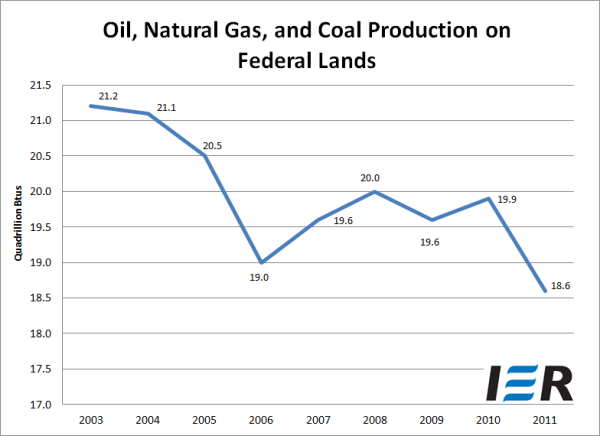Last fall the U.S. government’s Energy Information Administration reported a 40 percent decline in oil and natural gas production on federal lands compared to 10 years ago.
The White House and a prominent liberal in Congress protested. They said EIA, a trusted source for reliable energy information, was wrong. They complained that EIA hadn’t accounted for all data from the Department of Interior.
EIA released an updated analysis last week. And while the number isn’t as drastic as originally reported, EIA confirmed the Obama administration is overseeing a sharp decline in fossil fuel production (coal, oil, and natural gas) on federal lands, which recently hit its lowest point in nine years.
The updated EIA report revealed a 12 percent decline in production for coal, oil, and natural gas on federal and Indian lands from fiscal 2003 through fiscal 2011.
During this same period, production on state and private lands has increased, boosting overall production numbers for the United States. That’s a point even President Obama will acknowledge: “Under my Administration, domestic oil and natural gas production is up,” he said upon announcing his rejection of the Keystone XL pipeline.
Obama is correct. He just can’t rightfully claim the credit, since the vast majority of America’s new oil and gas production is happening on private lands in states like North Dakota, Alaska and Texas.
The administration, meanwhile, has also taken several steps to limit production. Heritage’s Nick Loris noted these four steps taken by the Obama administration:
- Withdrew areas offered for 77 oil and gas leases in Utah that could cost American taxpayers millions in lost lease bids, production royalties, new jobs and the energy needed to offset rising imports of oil and natural gas.
- Cancelled lease sales in the Western Gulf of Mexico, the Atlantic coast and delayed exploration off the coast of Alaska and kept other resource-rich areas off-limits.
- Finalized rules, first announced by Secretary Salazar on January 6, 2010, to establish more government hurdles to onshore oil and natural gas production on federal lands.
- Withdrew 61 oil and natural gas leases in Montana as part of a lawsuit settlement over climate change.
“The big picture is clear that government policies undertaken by the Obama administration have produced a significant decline in offshore oil production on federal lands in fiscal year 2011,” the Institute for Energy Research said in response to last week’s updated EIA analysis. “That is certainly not a way to increase domestic production of oil and keep oil and thus gasoline prices in check.”
While it was waiting for EIA to update its numbers, the Institute for Energy Research conducted its own analysis of Department of Interior data in February. It came to the same conclusion: “Production on federal lands is down, while production on state and private lands is up.”
